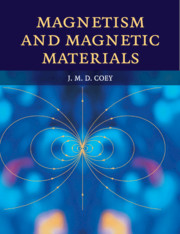Book contents
- Frontmatter
- Contents
- List of tables of numerical data
- Preface
- Acknowledgements
- 1 Introduction
- 2 Magnetostatics
- 3 Magnetism of electrons
- 4 Magnetism of localized electrons on the atom
- 5 Ferromagnetism and exchange
- 6 Antiferromagnetism and other magnetic order
- 7 Micromagnetism, domains and hysteresis
- 8 Nanoscale magnetism
- 9 Magnetic resonance
- 10 Experimental methods
- 11 Magnetic materials
- 12 Applications of soft magnets
- 13 Applications of hard magnets
- 14 Spin electronics and magnetic recording
- 15 Special topics
- Appendices
- Formula index
- Index
- Tables, conversions, constants and units
15 - Special topics
Published online by Cambridge University Press: 05 June 2012
- Frontmatter
- Contents
- List of tables of numerical data
- Preface
- Acknowledgements
- 1 Introduction
- 2 Magnetostatics
- 3 Magnetism of electrons
- 4 Magnetism of localized electrons on the atom
- 5 Ferromagnetism and exchange
- 6 Antiferromagnetism and other magnetic order
- 7 Micromagnetism, domains and hysteresis
- 8 Nanoscale magnetism
- 9 Magnetic resonance
- 10 Experimental methods
- 11 Magnetic materials
- 12 Applications of soft magnets
- 13 Applications of hard magnets
- 14 Spin electronics and magnetic recording
- 15 Special topics
- Appendices
- Formula index
- Index
- Tables, conversions, constants and units
Summary
Disciplines grow at their boundaries. The interdisciplinary topics considered here fall into three groups. One is mainly concerned with liquids: paramagnetic liquids, ferrofluids, magnetic levitation and confinement, and magnetoelectrochemistry. The second relates to life sciences: magnetism in biology and medicine, magnetic imaging and magnetically aided diagnostics. Finally there is planetary and stellar magnetism, covering the magnetism of rocks and the Earth's magnetic field, as well as and those of other planets, the Sun and stars.
Magnetism has been a spur to human curiosity for centuries. The force field with its attractive and repulsive interactions led to dreams of levitation and perpetual motion, and hopes for cures of illness, as well as a striving for understanding. These hopes and dreams have been realized in unexpected ways. Magnetism is a mature discipline with a secure physical foundation, which allows it to engage in interdisciplinary joint ventures with other branches of science.
If perpetual motion has proved to be a pipe dream – periodically revived to peddle to gullible investors – it nevertheless finds an echo in the stationary states of quantum mechanics where the electrons occupy quantized orbits. There, they enjoy undiminished motion, at least until they exchange a quantum of energy with their environment. But they can do no work in their stationary states. Energy conservation is inviolate.
Levitation is a more practical proposition, but again not as people imagined long ago – for example, Jonathan Swift's island of Laputa, the ‘coffin of the Prophet’ in Medina or the golden idol in the temple of Somnath.
- Type
- Chapter
- Information
- Magnetism and Magnetic Materials , pp. 542 - 579Publisher: Cambridge University PressPrint publication year: 2010
- 1
- Cited by

